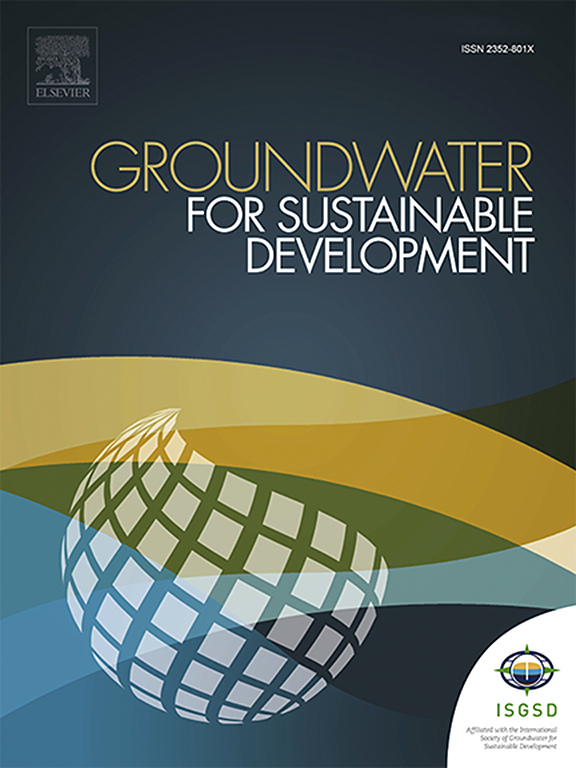印度西孟加拉邦流行地区人群长期摄入砷的慢性毒性:促进更好的管理以减轻未来的风险
IF 4.9
Q2 ENGINEERING, ENVIRONMENTAL
引用次数: 0
摘要
本研究的重点是评估目前饮用水和最常食用的食物来源(如米粒和豆类)中的砷污染情况,以及与之相关的巴兰达希布纳加尔人口的慢性毒性暴露;位于印度西孟加拉邦穆尔西达巴德地区穆尔西达巴德-贾甘吉街区的一个村庄。采用蒙特卡罗模拟对概率风险进行建模,并确定对砷相关健康风险贡献最大的因素。在这一高风险区域进行了有限的概率风险评估。结果显示,饮用水(24.5 μg/l)和大米(201 μg/kg)中砷的平均含量超过了可接受限度,而豆类(26.5 μg/kg)被认为是安全的。此外,研究人群慢性毒性生物标志物中的As积累也高于阈值(头发和指甲分别为100%和96%)。此外,研究人员还观察到砷摄入与生物标志物积累之间存在显著相关性,这反映了头发和指甲中砷水平的年龄依赖性增加。然而,研究发现,性别对慢性生物标志物中的砷积累没有实质性影响。砷的主要暴露途径为稻米,其次为饮用水和豆类。研究发现,成年男性的每日As总摄入量(edittal)最高,这与他们较高的致癌风险(CR)相关,其次是女性和儿童。儿童的非致癌性风险(NCR)非常高,根据敏感性测试结果,可摄入来源中的砷浓度是导致非致癌性风险的最重要因素,其次是暴露时间(ED)。这些调查结果强调需要立即在水管理和农业做法方面采取干预措施,以减少砷接触,并优先考虑提供砷安全饮用水的必要性,以保护人类健康免受其毒性后果的影响。本文章由计算机程序翻译,如有差异,请以英文原文为准。

Chronic toxicity through prolonged arsenic ingestion among population from endemic area of West Bengal, India: Promoting better management to mitigate future risk
This study focused on evaluating the present arsenic (As) contamination scenario in drinking water and the most consumed food sources such as rice grain and pulses along with its associated chronic toxicity exposure among population from Baranda Shibnagar; a village located in the Murshidabad-Jiaganj block of Murshidabad district, West Bengal, India. A Monte Carlo Simulation was employed to model probabilistic risk and identify the factors contributing most to arsenic-related health risks. Limited probabilistic risk assessments have been conducted in this high-risk region. The findings revealed a higher mean As levels in drinking water (24.5 μg/l) and rice grain (201 μg/kg) surpassing the acceptable limit, whereas, pulses (26.5 μg/kg) were considered to be safe. Besides, As accumulation in chronic toxicity biomarkers of the studied population was also found higher (100% and 96% for hair and nails, respectively) than the threshold values. Furthermore, a significant correlation was observed between As ingestion and biomarker accumulation, reflecting an age-dependent increase in As levels in hair and nails. However, gender was found to have no substantial impact on As accumulation in chronic biomarkers. Among all the sources, rice grain was found as the primary route of As exposure followed by drinking water and pulses. The total estimated daily intake of As (EDITotal) was found to be highest in adult males, correlating with their heightened carcinogenic risk (CR), followed by females and children. Non-carcinogenic risks (NCR) were notably high among children and according to the sensitivity test result, As concentration in ingestible sources was found to be the most significant component contributing to the CR and NCR followed by exposure duration (ED). These findings underscore the need for immediate interventions in water management and agricultural practices to reduce As exposure and prioritise the necessity for As-safe drinking water to protect human health from its toxic consequences.
求助全文
通过发布文献求助,成功后即可免费获取论文全文。
去求助
来源期刊

Groundwater for Sustainable Development
Social Sciences-Geography, Planning and Development
CiteScore
11.50
自引率
10.20%
发文量
152
期刊介绍:
Groundwater for Sustainable Development is directed to different stakeholders and professionals, including government and non-governmental organizations, international funding agencies, universities, public water institutions, public health and other public/private sector professionals, and other relevant institutions. It is aimed at professionals, academics and students in the fields of disciplines such as: groundwater and its connection to surface hydrology and environment, soil sciences, engineering, ecology, microbiology, atmospheric sciences, analytical chemistry, hydro-engineering, water technology, environmental ethics, economics, public health, policy, as well as social sciences, legal disciplines, or any other area connected with water issues. The objectives of this journal are to facilitate: • The improvement of effective and sustainable management of water resources across the globe. • The improvement of human access to groundwater resources in adequate quantity and good quality. • The meeting of the increasing demand for drinking and irrigation water needed for food security to contribute to a social and economically sound human development. • The creation of a global inter- and multidisciplinary platform and forum to improve our understanding of groundwater resources and to advocate their effective and sustainable management and protection against contamination. • Interdisciplinary information exchange and to stimulate scientific research in the fields of groundwater related sciences and social and health sciences required to achieve the United Nations Millennium Development Goals for sustainable development.
 求助内容:
求助内容: 应助结果提醒方式:
应助结果提醒方式:


